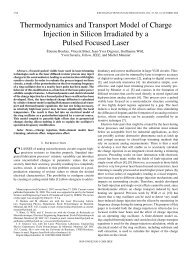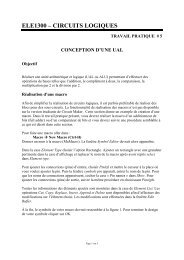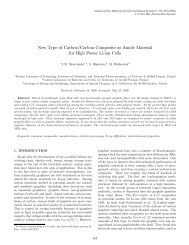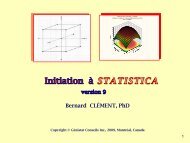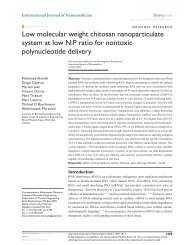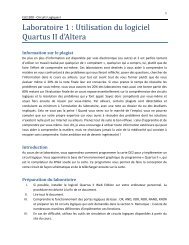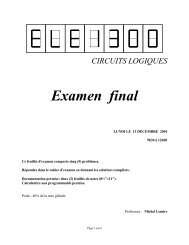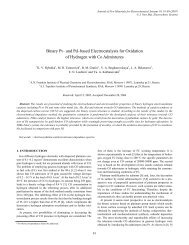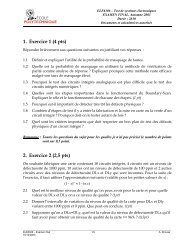Photoacoustic Fourier transform infrared spectroscopy of ...
Photoacoustic Fourier transform infrared spectroscopy of ...
Photoacoustic Fourier transform infrared spectroscopy of ...
You also want an ePaper? Increase the reach of your titles
YUMPU automatically turns print PDFs into web optimized ePapers that Google loves.
JOURNAL OF APPLIED PHYSICS 98, 114310 2005<br />
<strong>Photoacoustic</strong> <strong>Fourier</strong> <strong>transform</strong> <strong>infrared</strong> <strong>spectroscopy</strong> <strong>of</strong> nanoporous<br />
SiO x /Si thin films with varying porosities<br />
D.-Q. Yang, M. Meunier, and E. Sacher a<br />
Regroupement Québécois de Matériaux de Pointe and Département de Génie Physique, École Polytechnique<br />
de Montréal, Casier Postal 6079, Succursale Centre-Ville, Montréal, Québec H3C 3A7, Canada<br />
Received 22 February 2005; accepted 21 October 2005; published online 9 December 2005<br />
Nanostructured SiO x /Si thin films, over a large range <strong>of</strong> porosities, were deposited by the excimer<br />
laser ablation KrF, 248 nm <strong>of</strong> Si targets in He; they have been characterized by photoacoustic<br />
<strong>Fourier</strong> <strong>transform</strong> <strong>infrared</strong> <strong>spectroscopy</strong>, which necessitates exposure to air with subsequent<br />
oxidation. In particular, the IR Si–O–Si asymmetric stretching region, from 1000 to 1300 cm −1 , has<br />
been found to be composed <strong>of</strong> four components: P 1 at 1045 cm −1 , P 2 at 1060 cm −1 , P 3 at<br />
1090 cm −1 , and P 4 at 1170 cm −1 . The photoacoustic signals were enhanced with increasing film<br />
porosity, as previously found for larger scale porous materials; those for P 2–4 also correlated with<br />
similar increases in the O–H and C–H n surface contaminant stretching peaks, indicating their<br />
sources to be in the surface region. We demonstrate that the experimental data fully support a<br />
previously proposed theoretical relationship, originally developed for powders. © 2005 American<br />
Institute <strong>of</strong> Physics. DOI: 10.1063/1.2138376<br />
I. INTRODUCTION<br />
Nanoporous Si thin films have attracted much interest<br />
over the last decade because they exhibit visible photoluminescence<br />
PL with quantum efficiencies <strong>of</strong> up to a few percent<br />
at room temperature, making them attractive materials<br />
for optoelectronic and biomedical device applications. 1,2<br />
Nanostructured Si prepared under different conditions exhibit<br />
PL <strong>of</strong> varying intensities, wavelengths, and band<br />
shapes. 3–9 Although the quantum confinement model <strong>of</strong><br />
PL 10,11 can accommodate some <strong>of</strong> the experimental data,<br />
they can equally well be explained by surface chemical composition<br />
e.g., siloxane derivatives 12 and SiH 2 Ref. 13, defects<br />
e.g., in the surface oxide 14 or at the SiO x /Si<br />
interface 15,16 , surface-bonded chemical moieties, 4,9,12–18 and<br />
surface electronic states. 18<br />
There are many analytical tools available to characterize<br />
surfaces and interfaces <strong>of</strong> these materials. For example, x-ray<br />
photoelectron XPS and <strong>Fourier</strong> <strong>transform</strong> <strong>infrared</strong> FTIR<br />
spectroscopies have been widely used to characterize Si<br />
nanostructured materials. 2,6,9,19–25 However, knowledge gathered<br />
from these techniques has only provided limited information<br />
on the understanding <strong>of</strong> the origin <strong>of</strong> PL.<br />
While many techniques have been used to produce porous<br />
Si, 19–21 pulsed laser ablation has the advantage over<br />
other methods in producing contaminant-free thin<br />
films 22,26–32 . The laser ablation <strong>of</strong> a silicon target, in residual<br />
He, leads to the deposition <strong>of</strong> nanoporous thin films. Because<br />
most <strong>of</strong> the kinetic energy <strong>of</strong> the ablated Si atoms and clusters<br />
is absorbed by the He gas, the tendency for larger particle<br />
growth is minimized. The microstructures formed depend<br />
on the parameters such as the gas pressure, sampletarget<br />
distance, substrate temperature, laser power,<br />
wavelength, etc., but all lead to a typical nanoparticle size <strong>of</strong><br />
5 nm. 31,33–35 These porous Si films are rapidly oxidized to<br />
a Electronic mail: edward.sacher@polymtl.ca<br />
SiO x /Si on exposure to air at room temperature, 33–35 this<br />
oxidation being one <strong>of</strong> the most important factors for the<br />
production <strong>of</strong> the PL.<br />
As we have noted, 32 the PL previously exhibited by Si<br />
thin films that were laser ablated in noble gases has produced<br />
conflicting results: some workers found that the PL was<br />
nearly independent <strong>of</strong> the preparation conditions, 27–29 while<br />
others found a strong experimental dependence. 31,32,36 Such<br />
films, produced by different groups, using different conditions,<br />
may well differ in chemical structure.<br />
Infrared IR <strong>spectroscopy</strong> is <strong>of</strong>ten used in the determination<br />
<strong>of</strong> chemical structure, in that the local chemical<br />
groups are characterized by their vibrational frequencies. In<br />
the case <strong>of</strong> SiO x , the band <strong>of</strong> frequencies between 1000 and<br />
1300 cm −1 is clearly identified with the presence <strong>of</strong><br />
Si–O–Si vibrations. 37 Several peaks are generally present in<br />
this region, whose attributions are necessary to an understanding<br />
<strong>of</strong> the chemical structure <strong>of</strong> the particular SiO x<br />
sample under study. Unfortunately, the literature is not in<br />
agreement with these attributions. This is made clear by perusing<br />
a representative sampling <strong>of</strong> two decades <strong>of</strong> experimental<br />
results <strong>of</strong> SiO x , 38–67 using data obtained on oxidized<br />
Si, siloxanes, and silsesquioxanes, both porous and nonporous,<br />
and produced by methods such as surface oxidation,<br />
plasma deposition, electrochemical etching, etc. These findings,<br />
which we do not tabulate here, are characterized by<br />
disagreements as to the number <strong>of</strong> peaks 2–5, whether their<br />
sources are local Si–O–Si or longer-range LO and TO<br />
vibrational modes, and their attributions cyclic, long chain,<br />
hydroxyl terminated, etc..<br />
Much <strong>of</strong> this inconsistency is certainly due to the different<br />
methods <strong>of</strong> sample preparation used, and the resulting<br />
differences in the chemical structures obtained. Thus, it<br />
would appear that attempting to attribute these peaks by reference<br />
to the literature has little to <strong>of</strong>fer. Rather, one must<br />
0021-8979/2005/9811/114310/6/$22.50<br />
98, 114310-1<br />
© 2005 American Institute <strong>of</strong> Physics<br />
Downloaded 09 Dec 2005 to 132.207.4.76. Redistribution subject to AIP license or copyright, see http://jap.aip.org/jap/copyright.jsp
114310-2 Yang, Meunier, and Sacher J. Appl. Phys. 98, 114310 2005<br />
submit one’s own samples to controlled conditions that are<br />
well understood, and make attributions based on their effects<br />
on the peaks under study.<br />
Conventional <strong>Fourier</strong> <strong>transform</strong> <strong>infrared</strong> FTIR <strong>spectroscopy</strong><br />
has been used to explore porous SiO x /Si thin-film<br />
microstructures in an effort to understand the origin <strong>of</strong><br />
PL. 43,44,47,52,54,63 On the other hand, photoacoustic PA FTIR<br />
has received little such attention, 45,68,69 including an early<br />
study on micrometer-sized silica power during the development<br />
<strong>of</strong> theoretical PA-FTIR models. 68,69 More recently PA-<br />
FTIR was used to measure the thermal conductivity <strong>of</strong> porous<br />
Si layers produced by wet chemistry. 70<br />
Here, we present PA-FTIR spectral data on nanoporous<br />
Si. This system has the advantage <strong>of</strong> surface and near surface<br />
sensitivities, over a range <strong>of</strong> He deposition pressures previously<br />
found to strongly affect the porosities <strong>of</strong> the Si films<br />
deposited, and to exhibit broad PL patterns with varying<br />
peak intensities and positions. 18,31 .<br />
II. EXPERIMENT<br />
Nanoporous Si thin-film deposition was carried in a<br />
high-vacuum laser ablation deposition system, using the KrF<br />
laser ablation GSI Lumonics, Inc., PulseMaster TM PM-800,<br />
=248 nm at 20 Hz, with a 20 ns full width at half maximum<br />
<strong>of</strong> a Si target in a high-purity He ambient. The laser<br />
radiation was focused on a spot 21 mm 2 on the target at an<br />
incident angle <strong>of</strong> 45°, giving a radiation intensity <strong>of</strong> 4<br />
10 8 W/cm 2 , while the target, at a distance <strong>of</strong> 3 cm from<br />
the substrate, was rotated at 3 rps. The base pressure in the<br />
preparation chamber was below 510 −7 torr and the He<br />
pressure was varied between 0.1 and 8 torr by adjusting the<br />
He mass flow meter. All were deposited at the same time<br />
using the same laser conditions, so that their deposited<br />
masses were similar. The film mass thickness thickness at<br />
zero porosity was kept constant at 200 nm, although the<br />
actual thicknesses differed up to 2 m because <strong>of</strong> the porosity<br />
differences, which were controlled by the He pressure<br />
during deposition.<br />
The porosities were determined by specular x-ray reflectivity<br />
SXRR, whose details may be found in a previous<br />
publication from our laboratory. 31 On exposure to air, these<br />
films rapidly oxidize to SiO x /Si, even during the short transfer<br />
time required for analysis, with the oxidation<br />
behavior 71,72 depending on both exposure time and film porosity.<br />
The samples used for the PA-FTIR study were exposed<br />
to air for at least 2 months because such exposure gave<br />
materials stable to further oxidation. 72<br />
PA-FTIR spectra were obtained using a He-purged<br />
MTEC 300 photoacoustic cell in a Bio-Rad FTS 6000 spectrometer.<br />
The 5 kHz modulation frequency used probed the<br />
entire sample thickness. The spectral resolution was set at<br />
4cm −1 .<br />
III. RESULTS<br />
A typical PA-FTIR spectrum, over the range <strong>of</strong><br />
700–4000 cm −1 , is shown in Fig. 1. One sees the results <strong>of</strong><br />
atmospheric reaction: water adsorption is demonstrated by<br />
the sharp O–H stretching peak at 3750 cm −1 free –OH<br />
FIG. 1. Representative PA-FTIR spectra <strong>of</strong> nanoporous SiO x /Sithinfilms,<br />
over the range <strong>of</strong> 700–4000 cm −1 .<br />
and the broad O–H stretching peak at 3400 cm −1<br />
hydrogen-bonded –OH. Further, the adsorption <strong>of</strong> airborne<br />
hydrocarbons is indicated by the C–H n stretching peaks near<br />
2900 cm −1 .<br />
The peaks near 2100 cm −1 , found for nanoporous thin<br />
films with high porosities, indicate the presence <strong>of</strong> SiH n<br />
Si–H n stretching and, possibly, hydrocarbon CvC<br />
stretching. Peaks near 1700 cm −1 indicate the presence <strong>of</strong><br />
adsorbed water H 2 O deformation and oxidized hydrocarbons<br />
CvO stretching. Oxide formation is signaled by the<br />
broadband <strong>of</strong> Si–O–Si stretching peaks in the range <strong>of</strong><br />
1000–1300 cm −1 . In addition, the Si, laser processed in air,<br />
has a Si–O–Si bending peak at 800 cm −1 , while the nanoporous<br />
Si, laser processed in He, has a peak near 880 cm −1 ,<br />
previously attributed to Si rings isolated by oxygen; 73 we<br />
have found this peak only for highly porous films.<br />
The Si–O–Si stretching peaks, in the range <strong>of</strong><br />
1000–1300 cm −1 , have received much study, partly because<br />
their high IR intensities made them so easy to study. Typical<br />
spectra, at several porosities, are found in Fig. 2a; for purposes<br />
<strong>of</strong> comparison, Si wafers treated in various ways 74,75<br />
are found samples A–F in Fig. 2b, whose sources are<br />
described in the figure caption. It is clear that 1 all can be<br />
fit with the same four component peaks at 1045 cm −1 P 1 ,<br />
1060 cm −1 P 2 , 1090 cm −1 P 3 , and 1170 cm −1 P 4 ; a<br />
typical deconvolution is found in Fig. 2c, with standard<br />
Gaussian functions having the same full width at half maximum<br />
FWHM value 30±2 cm −1 , except for P 4<br />
60±2 cm −1 , and 2 their relative peak areas are dependent<br />
on porosity Fig. 3 and surface treatment.<br />
The PA-FTIR signal intensity <strong>of</strong> each <strong>of</strong> these peaks is<br />
noticeably enhanced with increasing porosity. An example is<br />
found in Fig. 3 for the P 4 peak 1170 cm −1 area. The other<br />
absorption bands exhibit similar behavior; these amplitude<br />
relationships are all semilogarithmic: log P 1 0.020<br />
porosity and log P 2–4 0.029porosity while proportionalities<br />
are given rather than equalities, it is clear that the<br />
slope <strong>of</strong> log P 1 differs from those <strong>of</strong> log P 2–4 . The ratios <strong>of</strong><br />
Downloaded 09 Dec 2005 to 132.207.4.76. Redistribution subject to AIP license or copyright, see http://jap.aip.org/jap/copyright.jsp
114310-3 Yang, Meunier, and Sacher J. Appl. Phys. 98, 114310 2005<br />
FIG. 3. <strong>Photoacoustic</strong> peak area <strong>of</strong> the P 4 Si–O–Si component peak <strong>of</strong><br />
nanoporous SiO x /Si thin films as a function <strong>of</strong> porosity. The line predicted<br />
by the theoretical model, using Eq. 1 Ref. 69, and taking the SiO x thickness<br />
into account 72 , is also shown.<br />
P 2–4 to P 1 all increase with porosity Fig. 4, as expected<br />
from the differing slopes, indicating that P 2–4 are more porosity<br />
sensitive than P 1 . In addition, the intensities <strong>of</strong> both<br />
the O–H stretching peak at 3400 cm −1 , and the C–H n<br />
stretching peaks at 2900 cm −1 increase with porosity not<br />
shown with slopes identical to those <strong>of</strong> P 2–4 .<br />
IV. DISCUSSION<br />
A. Surface-volume distribution <strong>of</strong> Si–O–Si peaks<br />
Our experimental data, in Fig. 2, clearly indicate that<br />
there are four discernable components contributing to the<br />
local Si–O–Si stretching vibrations. The components maintain<br />
their positions for all the samples in Fig. 2, with P 1<br />
appearing to depend less on the SiO x porosity than P 2–4 . The<br />
fact that both the O–H and C–H n stretching peaks are due to<br />
surface depositions, and have porosity-dependent slopes essentially<br />
identical to those <strong>of</strong> P 2–4 indicates that P 2–4 have<br />
their origins at the free surface. This is consistent with pre-<br />
FIG. 2. PA-FTIR spectra <strong>of</strong> the Si–O–Si stretching region <strong>of</strong> a nanoporous<br />
SiO x /Si thin films and b variously treated Si thin films, prepared<br />
for other studies, and used for purposes <strong>of</strong> comparison including A, 5 nm<br />
Au, dc sputtered onto a native oxide-covered Si wafer surface; B, 3 nm Au,<br />
evaporated onto an O 2 plasma-treated Si wafer surface; C, SiO x microtrees<br />
formed on Si by KrF excimer laser radiation 248 nm in air Ref. 75; D,<br />
3 nm Au, evaporated onto a native oxide-covered Si wafer surface; E, an<br />
untreated native oxide-covered Si wafer; F, a high-temperature thermally<br />
growth 250 nm SiO 2 thin film on Si; c a typical deconvolution <strong>of</strong> Si–O–Si .<br />
FIG. 4. The P 2 : P 1 , P 3 : P 1 , and P 4 : P 1 component peak intensity ratios <strong>of</strong><br />
nanoporous SiO x /Si thin films as a function <strong>of</strong> porosity.<br />
Downloaded 09 Dec 2005 to 132.207.4.76. Redistribution subject to AIP license or copyright, see http://jap.aip.org/jap/copyright.jsp
114310-4 Yang, Meunier, and Sacher J. Appl. Phys. 98, 114310 2005<br />
vious FTIR observations 45 <strong>of</strong> silicon dioxide thin films with<br />
different porosities, deposited by a liquid-phase-deposition<br />
technique. The presence <strong>of</strong> three adjacent surface-related<br />
peaks suggests slight differences in their structures, possibly<br />
due to –OH and –CH n terminations and/or short-rangedisordered<br />
Si–O–Si chain/cyclic surface structures. 37 As<br />
mentioned earlier, they have already been characterized in<br />
the literature 38–67 by disagreements as to a the number <strong>of</strong><br />
peaks 2–5, b their sources, which have been variously<br />
suggested to be local Si–O–Si or longer-range LO and<br />
TO vibrational modes, and c their attributions cyclic, long<br />
chain, hydroxyl terminated, etc.. While the present results<br />
are able to indicate their surface and volume contributions,<br />
they bring us no closer to attributing them with any precision.<br />
It is interesting to note that the band at 880 cm −1 with a<br />
shoulder at lower wave numbers, which has been attributed<br />
to silicon ring configurations isolated by oxygen atoms, 73 as<br />
well as the Si–O–Si bending peak at 800 cm −1 , is not seen<br />
at low porosities. The 880 cm −1 peak is also found in SiO x<br />
microtrees, 75 produced by the excimer laser processing <strong>of</strong> Si<br />
in air, as well as in O 2 plasma-treated Si surfaces Fig. 2b,<br />
and surfaces produced by the CO 2 laser-provoked optical<br />
breakdown <strong>of</strong> air; 76 they do not appear in highly porous SiO x<br />
nanoparticulate thin films 77 produced by the excimer laser<br />
ablation <strong>of</strong> a Si target in He/O 2 .<br />
As seen in Fig. 2, the enhancement <strong>of</strong> P 2–4 over P 1 ,<br />
with increasing porosity greater slopes, leads to the increased<br />
width <strong>of</strong> the composite peak from 85 cm −1 for a<br />
sample having 10% porosity to 210 cm −1 for a sample having<br />
92% porosity. As a result, the composite peak maximum<br />
shifts from 1040 cm −1 10% porosity to 1075 cm −1 92%<br />
porosity. This change in the relative heights <strong>of</strong> the component<br />
peaks with a change <strong>of</strong> the surface: volume ratio appears<br />
to us to be the reason for the changes seen in composite<br />
peak width and maxima, with treatment, as cited by other<br />
workers. 39–42,44,45,57<br />
B. Surface-enhanced PA-FTIR signal<br />
The photoacoustic signal is due to the absorption <strong>of</strong> IR<br />
energy and its conversion to heat; at the sample surface, this<br />
heat causes an increase in the pressure above the gas, which<br />
is monitored by a sensitive microphone. The enhancement <strong>of</strong><br />
this signal in porous solids has been known for more than<br />
100 years, 78 and several models have been developed to describe<br />
it. 68,69,79–82 It is now known to result from the increased<br />
pressure change <strong>of</strong> the gas above the sample due to<br />
the presence <strong>of</strong> increased surface area in the gas-filled pores<br />
connected to the sample surface. Thus, the PA signal has two<br />
contributions: 68,69,81,82 a thermal component I th independent<br />
<strong>of</strong> the sample porosity, and a component due to the expansion<br />
<strong>of</strong> the gas in the pores. Based on prior work on<br />
powders, 68,82 McGovern et al. 69 proposed the following<br />
model for this signal enhancement:<br />
I = AI th +<br />
<br />
0<br />
0<br />
1− 1−e−1− a l<br />
, 1<br />
a<br />
where A is a constant which depends on several components:<br />
the static gas pressure in the cell, the light absorption coefficient<br />
<strong>of</strong> the sample, the cell temperature, the heat capacity<br />
<strong>of</strong> the solid, and the cell volume. 69 I th is the contribution <strong>of</strong><br />
the thermal portion <strong>of</strong> the PA signal, which is independent <strong>of</strong><br />
the sample porosity, 0 a is the optical absorption coefficient<br />
<strong>of</strong> the sample, is the sample porosity, and l is the sample<br />
thickness. Because we use the same mass thickness i.e.,<br />
thickness at zero porosity l 0 200 nm for each sample, the<br />
apparent thickness l can be expressed as<br />
1<br />
l = l 0<br />
1− .<br />
2<br />
We take the thickness <strong>of</strong> the SiO x coating into account 72<br />
SiO x /Si is assumed to be spherical as<br />
d = d 0 0.8 ,<br />
3<br />
where d is the SiO x coating thickness, 72 and the power 0.8<br />
comes from an experimental fit <strong>of</strong> the porosity data; 72 converting<br />
the sample thickness into porosity by Eq. 2, we plot<br />
the theoretical model <strong>of</strong> Eq. 1 in Fig. 3. The resultant plot,<br />
using the signal from sample F, a 250 nm nonporous SiO 2<br />
thin film, as the thermal contribution I th , shows our experimental<br />
data to be in excellent agreement with the theoretical<br />
model.<br />
It is important to note that our semilogarithmic experimental<br />
results, in Fig. 3, are identical to the experimental<br />
results obtained for the gas permeabilities <strong>of</strong> H 2 and air in<br />
SiO x /Si films, 83 indicating that the pores formed in our study<br />
are open cell. It is also a further confirmation that the enhanced<br />
PA-FTIR intensity comes from gas expansion in<br />
those pores. In contradistinction, there is no significant enhancement<br />
<strong>of</strong> the PA-FTIR signal intensity in the transmission<br />
FTIR spectra <strong>of</strong> porous SiO x thin films. 45<br />
While we are limited in attributing the Si–O–Si stretching<br />
peaks to specific chemical structures, there are certain<br />
aspects <strong>of</strong> their behaviors that have been revealed by our<br />
data: 1 there appear to be four peaks contributing to the<br />
composite at 1045 cm −1 P 1 , 1060 cm −1 P 2 , 1090 cm −1<br />
P 3 , and 1170 cm −1 P 4 ; 2 P 2–4 are surface related; 3<br />
P 1 , which is also present in nonporous material, is less influenced<br />
by porosity here than the other components and may<br />
not be related to the surface area, implying that it may be<br />
volume related and undergo some minor surface enhancement;<br />
4 the different positions <strong>of</strong> P 2–4 may be related to<br />
different chain terminations e.g., Si–OH and Si–CH 3 <br />
and/or surface structures.<br />
Although our ability to attribute the source <strong>of</strong> the PL<br />
from our PA and previously published transmission FTIR<br />
studies is limited, we may combine our previous PL study 31<br />
with literature PL results 18,84 to note that a the PL intensity<br />
increases with porosity after correcting mass, and b the<br />
PL peak energy decreases from 2.3 to 1.6 eV with increasing<br />
porosity. As we have already proposed, 77 the band near<br />
2.3 eV appears to be associated with oxide-related defect<br />
states in the volume, the peak energy changing with x in<br />
SiO x , while the band near 1.5 eV is associated with surface<br />
states. Therefore, both the oxide-related defect state concentration<br />
shell thickness and the surface area increase with<br />
Downloaded 09 Dec 2005 to 132.207.4.76. Redistribution subject to AIP license or copyright, see http://jap.aip.org/jap/copyright.jsp
114310-5 Yang, Meunier, and Sacher J. Appl. Phys. 98, 114310 2005<br />
increasing porosity, which serves to increase the PL intensity.<br />
At the same time, the x value increases with increasing<br />
porosity, 72 shifting the peak energy.<br />
V. CONCLUSIONS<br />
We have found that the asymmetric Si–O–Si stretching<br />
peak, a composite in the range <strong>of</strong> 1000–1300 cm −1 , contains<br />
four clearly discernable peaks, one <strong>of</strong> which P 1 may come<br />
from the sample volume and the others P 2–4 certainly come<br />
from the sample surface. The enhanced PA signal is in good<br />
agreement with the previously proposed theoretical model <strong>of</strong><br />
McGovern et al., 69 in which signal enhancement comes from<br />
gas expansion in the sample pores. High porosity Si thin<br />
films may serve as substrates for PA-FTIR chemical sensors<br />
for trace materials.<br />
ACKNOWLEDGMENTS<br />
The authors thank the Natural Sciences and Engineering<br />
Research Council <strong>of</strong> Canada for funding, and Vincent Ethier<br />
for sample preparation.<br />
1 L. Pavesi, L. Dal Negro, C. Mazzolenl, G. Franzo, and F. Priolo, Nature<br />
London 408, 4402000.<br />
2 V. S.-Y. Lin, K. Motesharei, K. P. S. Dancil, M. J. Sailor, and M. R.<br />
Ghadiri, Science 278, 840 1997.<br />
3 Y. Kanemitsu, Phys. Rep. 263, 11995.<br />
4 A. G. Gullis, L. T. Canham, and P. D. J. Calcott, J. Appl. Phys. 82, 909<br />
1997.<br />
5 S. M. Prokes, Appl. Phys. Lett. 62, 32441993.<br />
6 K. S. Min, K. V. Shcheglov, C. M. Yang, H. A. Atwater, M. L. Brongersma,<br />
and A. Polman, Appl. Phys. Lett. 69, 2033 1996.<br />
7 M. Ehbrecht, B. Kohn, F. Huisken, M. A. Laguna, and V. Paillard, Phys.<br />
Rev. B 56, 69581997.<br />
8 G. Ledoux, J. Gong, and F. Huisken, Appl. Phys. Lett. 79, 4028 2001.<br />
9 I. Umezu, K.-I. Yoshida, N. Sakamoto, T. Murota, Y. Takashima, M.<br />
Inada, and A. Sugimura, J. Appl. Phys. 91, 2009 2002.<br />
10 L. T. Canham, Appl. Phys. Lett. 57, 10461990.<br />
11 B. Delley and E. F. Steigmeier, Phys. Rev. B 47, 1397 1993.<br />
12 M. S. Brandt, H. D. Fuchs, M. Stutzmann, J. Weber, and M. Cardona,<br />
Solid State Commun. 81, 307 1992.<br />
13 C. Tsai et al., Appl. Phys. Lett. 60, 1700 1992.<br />
14 S. M. Prokes and W. E. Carlos, J. Appl. Phys. 78, 26711992; L.N.<br />
Dinh, L. L. Chase, M. Balooch, L. J. Terminello, and F. Wooten, Appl.<br />
Phys. Lett. 65, 3111 1994; T. Torchynska et al., Physica B 308, 1108<br />
2002.<br />
15 Y. Kanemitsu, T. Futagi, T. Matsumoto, and H. Mimura, Phys. Rev. B 49,<br />
14732 1994.<br />
16 G. Allan, C. Delerue, and M. Lannoo, Phys. Rev. Lett. 76, 29611996.<br />
17 J. L. Gole, F. P. Dudel, L. Seals, M. Reiger, P. Kohl, and L. A. Bottomley,<br />
J. Electrochem. Soc. 145, 32841998.<br />
18 M. V. Wolkin, J. Jorne, P. M. Fauchet, G. Allan, and C. Delerue, Phys.<br />
Rev. Lett. 82, 1971999.<br />
19 S. Hayashi, S. Tanimoto, and K. Yamamoto, J. Appl. Phys. 68, 5300<br />
1990.<br />
20 P. Melinon et al., J. Chem. Phys. 107, 10278 1997.<br />
21 K. Furnkawa, Y. C. Liu, H. Nakashima, D. W. Gao, K. Uchino, K. Muraoka,<br />
and H. Tuzuki, Appl. Phys. Lett. 72, 725 1998.<br />
22 T. Makino, Y. Yamada, N. Suzuki, T. Yoshida, and S. Onari, J. Appl. Phys.<br />
90, 5075 2001.<br />
23 S.-T. Li, S. J. Silvers, and M. S. El-Shal, J. Phys. Chem. B 101, 1794<br />
1997.<br />
24 A. Brun-Bruneau, D. Souche, S. Fisson, V. N. Van, G. Vuye, F. Abeles,<br />
and J. Rivory, J. Vac. Sci. Technol. A 16, 2281 1998.<br />
25 S. Charvet, R. Madelon, R. Rizk, B. Garrido, O. Gonzalez-Varona, M.<br />
Lopez, A. Perez-Rodriguez, and J. R. Morante, J. Lumin. 80, 241 1999.<br />
26 E. Werwa, A. A. Seraphin, L. A. Chiu, C. Zhou, and K. D. Kolenbrander,<br />
Appl. Phys. Lett. 64, 1821 1994.<br />
27 I. A. Movtchan, R. W. Dreyfus, W. Marine, M. Sentis, M. Autric, G. Le<br />
Lay, and N. Merk, Thin Solid Films 255, 286 1995.<br />
28 Y. Yamada, T. Orii, I. Umezu, S. Takeyama, and T. Yoshida, Jpn. J. Appl.<br />
Phys., Part 1 35, 1361 1996.<br />
29 T. Makimura, Y. Kunii, and K. Murakami, Jpn. J. Appl. Phys., Part 1 35,<br />
4780 1996.<br />
30 L. Patrone, D. Nelson, V. I. Safarov, M. Sentis, W. Marine, and S. Giorgio,<br />
J. Appl. Phys. 87, 3829 2000.<br />
31 A. V. Kabashin, J.-P. Sylvestre, S. Patskovsky, and M. Meunier, J. Appl.<br />
Phys. 91, 3248 2002.<br />
32 A. V. Kabashin, M. Meunier, and R. Leonelli, J. Vac. Sci. Technol. B 19,<br />
2217 2001.<br />
33 G. Ledoux, O. Guillois, D. Porterat, C. Reynaud, F. Huisken, B. Kohn, and<br />
V. Paillard, Phys. Rev. B 62, 15942 2000.<br />
34 T. Yoshida, S. Takeyama, Y. Yamada, and K. Mutoh, Appl. Phys. Lett. 68,<br />
1772 1996.<br />
35 L. Patrone, D. Nelson, V. I. Safarov, M. Sentis, W. Marine, and S. Giorgio,<br />
J. Appl. Phys. 87, 3829 2000.<br />
36 I. Umezu, K. Shibata, S. Yamaguchi, A. Sugimura, Y. Yamada, and T.<br />
Yoshida, J. Appl. Phys. 84, 6448 1998.<br />
37 See, e.g., L. J. Bellamy, The Infra-Red Spectra <strong>of</strong> Complex Molecules<br />
Wiley, New York, 1959, Chap. 20.3 and references therein.<br />
38 H. Wagner and W. Beyer, Solid State Commun. 48, 5851983.<br />
39 P. G. Pai, S. S. Chao, and Y. Takagi, J. Vac. Sci. Technol. A 4, 689 1986.<br />
40 I. W. Boyd, Appl. Phys. Lett. 51, 418 1987.<br />
41 I. W. Boyd, J. Appl. Phys. 62, 3195 1987.<br />
42 R. M. Almeida and C. G. Pantano, J. Appl. Phys. 68, 4225 1990.<br />
43 H. D. Fuchs, M. Stutzmann, M. S. Brandt, M. Rosenbauer, J. Weber, A.<br />
Breitschwerdt, P. Deàk, and M. Cardonna, Phys. Rev. B 48, 81721993.<br />
44 I. Montero, L. Galán, O. Najmi, and J. M. Albella, Phys. Rev. B 50, 4881<br />
1994.<br />
45 J.-S. Chou and S.-C. Lee, J. Appl. Phys. 77, 1805 1995.<br />
46 J. M. Rehm, G. L. McLendon, L. Tsybeskov, and P. M. Fauchet, Appl.<br />
Phys. Lett. 66, 3669 1995.<br />
47 E. I. Kamitsos, Phys. Rev. B 53, 14659 1996.<br />
48 R. M. Almeida, Phys. Rev. B 53, 14656 1996.<br />
49 S. E. Babayan and J. Y. Jeong, Plasma Sources Sci. Technol. 7, 286<br />
1998.<br />
50 J. Eng, Jr., et al., J. Chem. Phys. 108, 8680 1998.<br />
51 M. J. Loboda, C. M. Grove, and R. F. Schneider, J. Electrochem. Soc.<br />
145, 2861 1998.<br />
52 R. R. Lowe-Webb, H. Lee, J. B. Ewing, S. R. Collins, W. Yang, and P. C.<br />
Sercel, J. Appl. Phys. 83, 2815 1998.<br />
53 J. J. Senkevich and S. B. Desu, Thin Solid Films 322, 148 1998.<br />
54 J. Wang, B. Zou, and M. A. El-Sayed, J. Mol. Struct. 508, 871999.<br />
55 W.-C. Chen, S.-C. Lin, B.-T. Dai, and M.-S. Tsai, J. Electrochem. Soc.<br />
146, 3004 1999.<br />
56 N. E. Korunskaya, T. V. Torchinskaya, L. Yu. Khomenkova, B. R. Dzhumaev,<br />
and S. M. Prokes, Microelectron. Eng. 51–52, 485 2000.<br />
57 K. T. Queeney, M. K. Weldon, J. P. Chang, Y. J. Chabal, A. B. Gurevich,<br />
J. Sapjeta, and R. L. Opila, J. Appl. Phys. 87, 1322 2000.<br />
58 M. K. Gunde, Physica B 292, 286 2000.<br />
59 C. Y. Wang, Z. X. Shen, and J. Z. Zheng, Appl. Spectrosc. 54, 2092000.<br />
60 K. Ragavachari and J. Eng, Jr., Phys. Rev. Lett. 84, 935 2000.<br />
61 S. E. Babayan, J. Y. Jeong, A. Schütze, V. J. Tu, M. Moravej, G. S.<br />
Selwyn, and R. F. Hicks, Plasma Sources Sci. Technol. 10, 5732001.<br />
62 G. Pérez and J. M. Sanz, Thin Solid Films 416, 242002.<br />
63 P. Innocenzi, J. Non-Cryst. Solids 316, 309 2003.<br />
64 T. Minami, T. Utsubo, T. Yamatani, T. Miyata, and Y. Ohbayashi, Thin<br />
Solid Films 426, 472003.<br />
65 V. E. Vamvakas and D. Davazoglu, J. Electrochem. Soc. 151, F93 2004.<br />
66 S. Yu, K. S. Wong, X. Hu, K. Pita, and V. Ligatchev, J. Electrochem. Soc.<br />
151, F123 2004.<br />
67 D. D. Burkey and K. K. Gleason, J. Vac. Sci. Technol. A 22, 612004.<br />
68 J. P. Monchalin, L. Bertrand, G. Rousset, and S. Lepoutre, J. Appl. Phys.<br />
56, 1901984.<br />
69 S. J. McGovern, B. S. H. Royce, and J. B. Benziger, J. Appl. Phys. 57,<br />
1710 1985.<br />
70 U. Bernini, P. Maddalena, E. Massera, and A. Ramaglia, J. Opt. A, Pure<br />
Appl. Opt. 1, 210 1999.<br />
71 D.-Q. Yang, J.-N. Gillet, M. Meunier, and E. Sacher, J. Appl. Phys. 97,<br />
024303 2005.<br />
72 D.-Q. Yang, M. Meunier, and E. Sacher, J. Appl. Phys. submitted.<br />
Downloaded 09 Dec 2005 to 132.207.4.76. Redistribution subject to AIP license or copyright, see http://jap.aip.org/jap/copyright.jsp
114310-6 Yang, Meunier, and Sacher J. Appl. Phys. 98, 114310 2005<br />
73 M. Zacharias, D. Dimova-Malinovska, and M. Stutzmann, Philos. Mag. B<br />
73, 799 1996; B. Gelloz and N. Koshida, J. Appl. Phys. 88, 4319<br />
2000; L. X. Yi, J. Heitman, R. Scholz, and M. Zacharias, Appl. Phys.<br />
Lett. 81, 4248 2002.<br />
74 D.-Q. Yang, E. Sacher, and M. Meunier, J. Appl. Phys. 95, 5023 2004;<br />
D.-Q. Yang, E. Sacher, and M. Meunier, Appl. Phys. A: Mater. Sci.<br />
Process. 80, 5752005.<br />
75 D.-Q. Yang, E. Sacher, and M. Meunier, Proc. SPIE 5578, 652 2004.<br />
76 D.-Q. Yang, A. V. Kabashin, V.-G. Pilon-Marien, E. Sacher, and M. Meunier,<br />
J. Appl. Phys. 95, 5722 2004.<br />
77 D.-Q. Yang, V. Ethier, E. Sacher, and M. Meunier, J. Appl. Phys. 98,<br />
024310 2005.<br />
78 A. G. Bell, Philos. Mag. 11, 510 1881.<br />
79 A. Rosencwaig and A. Gersho, J. Appl. Phys. 47, 641976.<br />
80 J. Pelzl, K. Klein, and O. Hordhaus, Appl. Opt. 21, 941982.<br />
81 F. A. McDonald and J. C. Wetsel, Jr., J. Appl. Phys. 49, 23131978.<br />
82 Z. A. Yasa, W. A. Jackson, and N. M. Amer, Appl. Opt. 21, 211982.<br />
83 A. Koponen, M. Kataja, and J. Timonen, Phys. Rev. E 56, 3319 1997; V.<br />
Lysenko, J. Vitiello, B. Remaki, and D. Barbier, ibid. 70, 017301 2004.<br />
84 P. M. Fauchet and J. Von Behren, Phys. Status Solidi B 204, R71997.<br />
Downloaded 09 Dec 2005 to 132.207.4.76. Redistribution subject to AIP license or copyright, see http://jap.aip.org/jap/copyright.jsp



